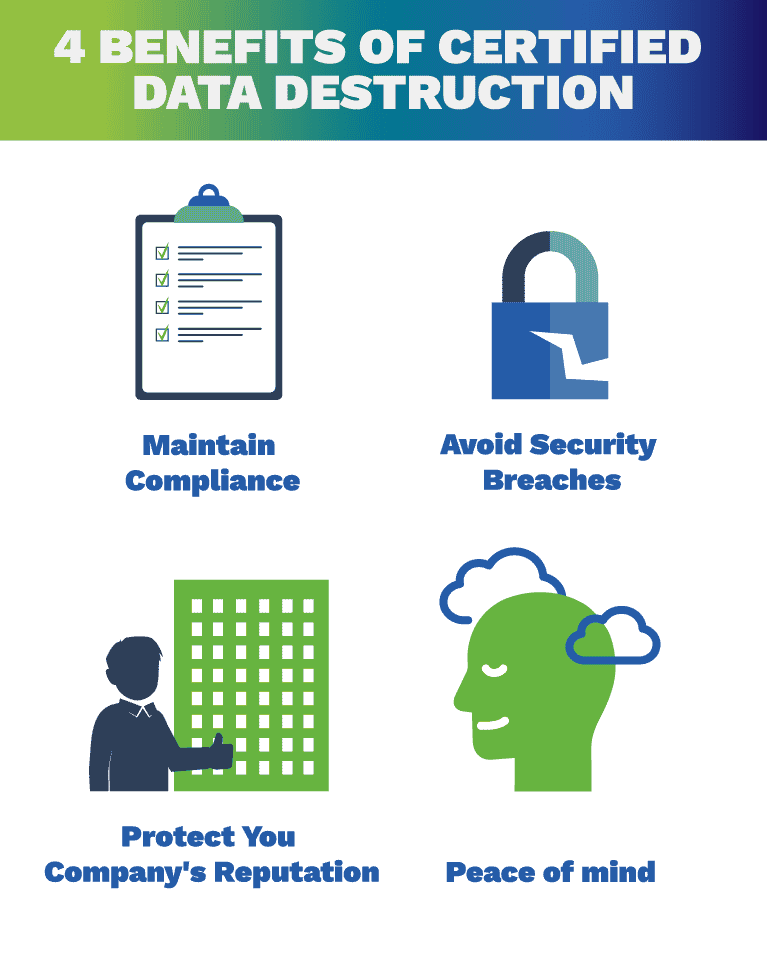The Effect of Effective Data Destruction on Cyber Security Risk Administration
The Effect of Effective Data Destruction on Cyber Security Risk Administration
Blog Article
Checking Out the Significance of Data Destruction in the Context of Computer System Protection Solutions and Protecting Confidential Data
In a period where information breaches are significantly typical, the significance of reliable data destruction can not be overemphasized. What strategies can organizations carry out to boost their information devastation methods?
Comprehending Data Devastation
Data damage is a vital element of computer security that includes the long-term elimination of information from storage gadgets to stop unauthorized gain access to and potential data violations. In an increasingly electronic landscape, organizations face heightened threats connected with sensitive information being incorrectly accessed or made use of. Efficient data destruction safeguards against these hazards, making sure that confidential dataâEUR" such as customer info, copyright, and economic recordsâEUR" can not be recouped after disposal.
Comprehending the importance of information damage prolongs beyond plain conformity with lawful and regulative structures; it is essential for keeping business stability and trust fund. When data is poorly managed or inadequately damaged, the consequences can be severe, including monetary loss, reputational damage, and legal liabilities.

Methods of Data Eradication

One common approach is information cleaning, which includes overwriting existing data with random patterns numerous times. This strategy renders the original information irretrievable, making it a prominent option for companies looking for to safeguard secret information.
An additional approach is degaussing, which makes use of an effective electromagnetic field to disrupt the magnetic domains on storage space devices, effectively erasing the data. This technique is specifically efficient for magnetic media but is not appropriate to solid-state drives.
Physical devastation is an additional robust approach, squashing or involving the shredding of storage gadgets. This approach guarantees that information healing is practically impossible, making it ideal for very sensitive information.
Last but not least, encryption can act as a complementary technique to information eradication. By securing data prior to removal, organizations can include an extra layer of protection, guaranteeing that even if residues are recuperated, they stay unattainable without the decryption key. Each technique needs to be selected based on the level of information level of sensitivity and the details protection needs of the organization.
Legal Compliance and Data Protection
Organizations need to navigate a complicated landscape of legal needs associated with data safety, particularly after applying approaches of data removal. Different guidelines, such as the General Information Protection Regulation (GDPR) and the Health Insurance Policy Portability and Responsibility Act (HIPAA), enforce rigorous standards on how organizations have to take care of and dispose of sensitive data. Failing to adhere to these laws can lead to substantial lawful effects, consisting of considerable penalties and reputational damages.
Information destruction procedures have to be meticulously documented to demonstrate compliance with appropriate regulations and criteria. This paperwork not only works as evidence of adherence to legal commitments yet additionally shows a commitment to safeguarding sensitive information. Organizations should likewise establish clear policies concerning data retention and destruction timelines, ensuring that information is not held longer than essential.

Moreover, website here normal audits and analyses of data destruction techniques are important to maintain conformity and adapt to progressing legal structures (data destruction). By proactively dealing with lawful demands, organizations can mitigate risks associated with data breaches and show their dedication to data protection. Eventually, prioritizing lawful conformity in data damage processes is not just a regulatory commitment, yet a basic element of a robust information safety and security technique
Influence on Organization Reputation
The online reputation of an organization can be substantially influenced by its approach to information damage and administration. In today's digital landscape, where data breaches can happen at any kind of moment, the failure to effectively take care of sensitive details can bring about serious consequences. Organizations that inadequately manage information destruction risk exposing private consumer info, which not just violates privacy regulations but likewise wears down depend on among customers and stakeholders.
A tarnished online reputation can cause lowered client loyalty, as customers end up being hesitant to involve with an organization that has demonstrated neglect in protecting their data. Additionally, unfavorable attention bordering an information breach can have a long-term effect, as prospective clients might be hindered by the regarded absence of safety. This can result in a straight click over here now decrease in profits and market share.
In addition, companies that focus on data damage as component of their security technique can improve their reputation by showcasing their commitment to safeguarding delicate info. By taking on stringent information administration practices, companies can not just alleviate dangers however additionally place themselves as trustworthy entities in their corresponding markets, therefore strengthening their total brand name photo.

Ideal Practices for Secure Disposal
Applying best practices for secure disposal of data is important for alleviating dangers related to data violations and making certain compliance with privacy policies. Organizations must take on a comprehensive data disposal policy that describes treatments for both digital and physical information damage.
For physical information storage space devices, such as hard drives, shredding or degaussing is advised to stop data healing. In addition, companies must preserve a chain of wardship documents throughout the disposal procedure, ensuring accountability and traceability of disposed products.
For electronic data, utilizing software program that complies with market standards for information cleaning is crucial. This software program should overwrite basics existing data multiple times, making healing practically difficult. It is likewise important to verify the efficiency of the information destruction process through audits or third-party evaluations.
Training employees on safe disposal practices includes another layer of safety, as human error can commonly cause data exposure. Regularly upgrading and reviewing disposal plans ensures placement with advancing guidelines and technical improvements. By implementing these ideal practices, companies can substantially decrease the danger of unauthorized data gain access to and improve their overall information security method.
Conclusion
In final thought, information damage is an essential facet of computer protection services that guarantees the protection of secret information from unapproved gain access to. Applying efficient techniques of information elimination, sticking to legal conformity, and acknowledging the influence on service track record are vital parts of a detailed information safety and security technique. By taking on finest techniques for safe disposal, organizations can foster trust with clients and protect sensitive information, inevitably adding to an extra protected electronic landscape.
In an age where information breaches are increasingly common, the importance of efficient data destruction can not be overemphasized.Information devastation is an essential part of computer system safety and security that involves the permanent elimination of data from storage gadgets to avoid unapproved access and potential data violations. Organizations must additionally develop clear policies relating to data retention and damage timelines, guaranteeing that data is not held longer than essential.
By proactively dealing with lawful demands, companies can reduce threats linked with data breaches and demonstrate their dedication to data safety and security (data destruction). Inevitably, prioritizing legal compliance in information damage processes is not simply a governing obligation, but an essential facet of a robust information safety approach
Report this page